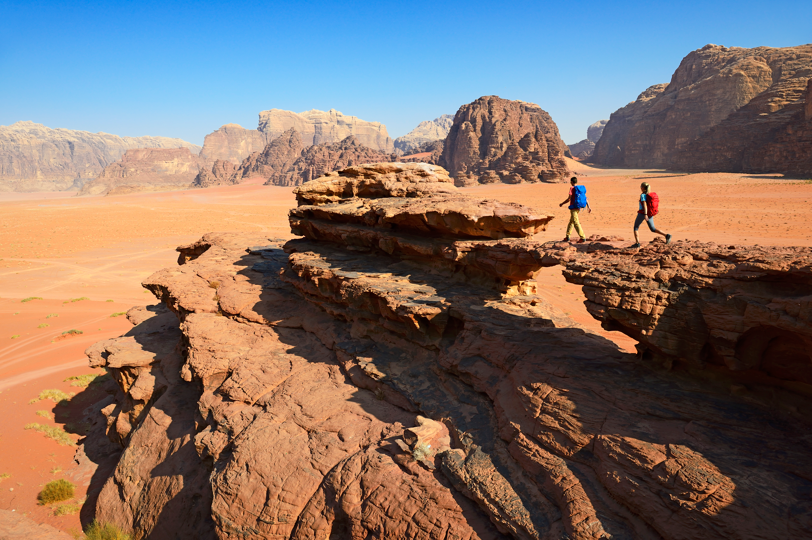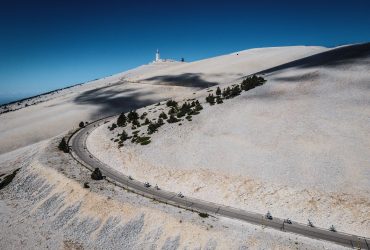Crossing Jordan from Umm-Qays in the north to Aqaba in the south, the Jordan Trail is an itinerary that takes visitors to the country's most beautiful sites, between history and sublime natural spots.
Officially, the Jordan Trail is not even 10 years old. Created in 2017, this route follows the Jordan River and the Israeli border for nearly 675 km. It takes about 40 days to complete in its entirety by hiking. An epic adventure that takes you through 52 villages across the different landscapes of Jordan always accompanied by the kindness of the locals. Trips of six or seven days are more commonly done by visitors (like those proposed by the website The Jordan Trail) and allow to enjoy various treks through the desert, the canyons and the mountains of the country. On our side, we were able to visit some emblematic places of the Jordan Trail and of Jordan in general. Fabulous points of passage along the famous Kings' Route on the western side of Jordan.
Umm Qais and its panorama on three countries
When the visitor stands on the large colonnaded terrace of Umm Qays (ancient Greek city of Gadara), the landscape invites contemplation. In the distance, one can see the Sea of Galilee (also known as Lake Tiberias), where several episodes in the life of Jesus are recounted in the Gospels, including the walking on the waters and the miraculous fishing. Upstream, the Golan Heights, former Syrian territory now occupied by the Israelis, tells a story of the Arab-Israeli conflict. Below, the Jordan River provides a natural border between Jordan and Israel. From here, the Jordan Trail heads to the south of the country.

As far as Ajloun, this is also the greenest part of Jordan. As you leave the road, a large sign reads in English and Arabic "The Beginning of the Jordan Trail". The trail begins on a 4×4 road, then winds along olive groves on rocky singles, quickly leaving the last villages behind. You come across herds of goats and their shepherds, and keep an eye on the water you've brought with you. Jordan is one of the most water-poor countries in the world, with rainfall of just 110 mm per year, while its arid climate and lack of lakes force the state to buy water from Israel on a regular basis.
Dead Sea : Between salt blocks and ochre cliffs
Going further south, the Dead Sea appears along the Jordan Trail. The landscape is beautiful and the blue of the sea contrasts with the white of its shores. On closer inspection, huge blocks of salt appear and accumulate on the coast. This salt lake surrounded by red ochre cliffs is not only the lowest point on the planet (- 430 meters above sea level) but also one of the saltiest lakes in the world to the point of preventing any macroscopic life and incidentally allowing swimmers to float without the slightest effort on the surface.
Unmissable Petra
In 2007, Petra became one of the seven new Wonders of the World designated by the "New Seven Wonders Foundation", independently of UNESCO. And to say that this title is well-deserved is an understatement, given the site's fascination with its splendour, its vastness and the beauty of its countless tombs. The city of Petra was carved out of stone by the Nabataeans over 2,000 years ago. A strategic crossroads at the junction of the Silk Roads, it was abandoned in the 15th century and rediscovered in 1812 by a Swiss traveller. Now a UNESCO World Heritage site, it welcomes many tourists, but remains so large that everyone can wander leisurely between the famous tomb of Khazneh (pictured below), temples, caves and tunnels.

Wadi Rum: hypnotic desert and breathtaking mountains
If you're in Petra and following the Jordan Trail, avoid heading due south and take time to discover the Wadi Rum desert. Two hours from Petra, this desert valley offers one of Jordan's most fabulous backdrops, and has been the setting for many films ("Dune", "Star Wars" or "Transformers 2"). The sunrises and sunsets are breathtaking, as are the sandstone formations rising out of the sand, through which you drive to reach the 200 Bedouin camps in the desert, which welcome visitors for a night or more.

For hiking, nothing beats being taken there by a local guide and venturing up the steep slopes offered by the impressive mountains set in the middle of the desert. It's easy to imagine Lawrence of Arabia, who came here at the beginning of the last century to settle in the village of Ram and discover these grandiose landscapes, only to tell the rest of the world about them. The British liaison officer won his battle against the Ottoman enemy here.

If the Jordan Trail is a must for outdoor activities in Jordan, other activities are possible elsewhere in the country:
An alternative in gravel or mountain bike
The Jordan Trail is best known for its hiking trail, but cyclists are not forgotten with the Jordan Bike Trail. The two itineraries regularly cross paths, although they don't always follow the same route. Some have tried it in gravel (like France's Axel Carion and Germany's Jonas Deichmann in the film below). But for greater comfort, we recommend semi-rigid mountain bikes. Elsewhere in the country, local service providers offer other cycling outings, such as these desert rides near the town of Azraq in the east of the country. An area where tourists are rarer and where it's possible to observe the local fauna in the Shaumari reserve, such as Arabian oryx, ostriches, gazelles and numerous birds.
Scuba diving in the Aqaba Marine Park
In the south of the country, Aqaba is the only port city in Jordan. The country has only 25 km of coastline between Israel and Saudi Arabia. However, this is enough to find beautiful diving spots in the Aqaba Marine Park (which is 7 km long) at the northern end of the Red Sea. The country takes particular care to protect its coral reef. The fauna and flora are very present there and can be seen while snorkeling or diving.

Hike with your feet in the water in the canyon of Wadi Al Hasa
Less well-known than Wadi Mujid (another canyon on which you can hike), Wadi Al Hasa is nevertheless well worth a visit. It winds from east to west to reach the Dead Sea near Al-Safi. Two-day hikes are possible, with an overnight bivouac, for a total distance of some twenty kilometers. As long as the water flow is limited, this water-based hike does not require any technical skills (abseiling, jumping or swimming).
To be sure to do it in the best conditions, take a guide with you. For the more athletic, it is probably possible to do about twenty kilometers of the canyon in one go, starting lighter without the equipment related to the bivouac. Except for a few shepherds and their goats, you will not see anyone and the place seems to be frozen in time. The cliffs surrounding the canyon play with the ochre, red and white colors, the water flows gently and hot springs coming from the mountain (nearly 40°C) can sometimes join the river bed. An umpteenth surprise that this surprising country that is Jordan offers. Find the places mentioned above, the hiking trails and the activities on the website of Jordan Tourism Office.
Vincent Girard 01/12/22











